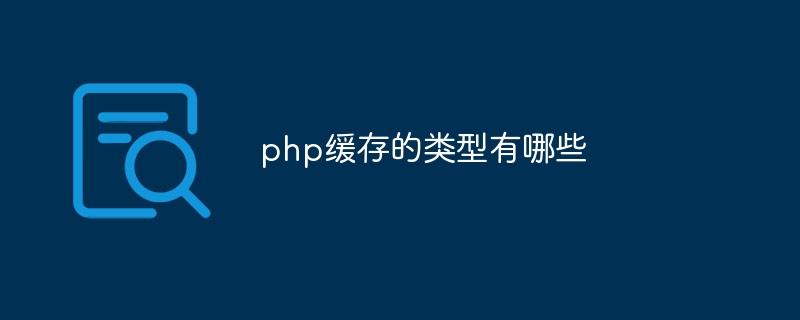
The types of PHP caching are: 1. Page caching, a technology that saves complete HTML pages in cache, which can significantly improve the loading speed and overall performance of web pages; 2. Data caching, which stores frequently accessed Data is stored in the cache to avoid frequent database query operations; 3. Fragment caching, a technology that caches specific parts of page content, can alleviate the pressure of dynamic page generation.

The operating system of this tutorial: Windows10 system, PHP version 8.1.3, DELL G3 computer.
PHP is a popular server-side scripting language that is widely used in website development. In PHP applications, caching is a common optimization technique that improves performance and reduces access to databases and other resources. PHP cache can be divided into many types, each type has different characteristics and application scenarios. This article will introduce common PHP cache types and their advantages and disadvantages.
1. Page caching
Page caching is a technology that saves complete HTML pages in the cache. When a user requests the same page, it is read directly from the cache and returned to the user without executing PHP code and querying the database. Page caching can significantly improve the loading speed and overall performance of web pages.
1. Static page saving cache
Static page saving cache saves the generated HTML page as a static file and stores it in the server file system. When multiple users request the same page, static files are returned directly without executing PHP code.
Advantages:
- Fast, no need to execute PHP code and query the database, just read directly from the static file.
- Easy to implement, just save the generated HTML page to the file system.
Disadvantages:
-Static files may take up more disk space, especially for websites with dynamic content or a large number of pages.
- If the content of the page is updated frequently, you need to update the static files manually or through scripts.
2. Dynamic page saving cache
Dynamic page saving cache is to save the generated HTML page in memory, usually using cache files, databases or in-memory databases.
Advantages:
- Compared with static page saving cache, it can reduce disk space usage.
- You can control the page update frequency by setting the cache life cycle.
Disadvantages:
- Requires additional memory resources.
- If caching is not handled properly, it may lead to expired page content or cache conflicts.
2. Data caching
Data caching is to save frequently accessed data in the cache, thereby avoiding frequent database query operations. Data cache is usually divided into two levels: application cache and data query cache.
1. Application cache
Application cache is a caching mechanism that saves data within the application. It can keep frequently accessed data in memory, updating and invalidating it as needed.
Advantages:
- Fast, can avoid frequent database query operations.
- Reduce the pressure on the database and improve the overall performance of the website.
Disadvantages:
- Requires additional memory resources.
- If the cache is not handled properly, it may cause data expiration or cache conflict problems.
2. Data query cache
Data query cache is a caching mechanism on the database server that can cache the results of data queries. When the same query is executed again, the results will be fetched from the cache without executing an actual database query.
Advantages:
- Fast and can avoid repeated database query operations.
- Reduce the load on the database.
Disadvantages:
- Requires sufficient memory resources to store cache data.
- If the data in the database is updated, the cache may become inconsistent.
3. Fragment caching
Fragment caching is a technology that caches specific parts of page content, which can alleviate the pressure of dynamic page generation. Fragment caching is usually used for pages with large dynamic content parts, such as large articles, comments, etc.
Advantages:
- It can avoid repeated processing and query operations and improve performance.
- The cache life cycle can be set as needed.
Disadvantages:
- Requires additional storage space to save cached data.
- If the content changes frequently, the cache needs to be updated manually or through a script.
To sum up, the types of PHP cache include page cache, data cache and fragment cache. Choosing the appropriate cache type can effectively improve website performance and user experience. However, when using cache, you need to pay attention to the cache update and invalidation mechanism to ensure data consistency and accuracy.
The above is the detailed content of What are the types of php cache?. For more information, please follow other related articles on the PHP Chinese website!